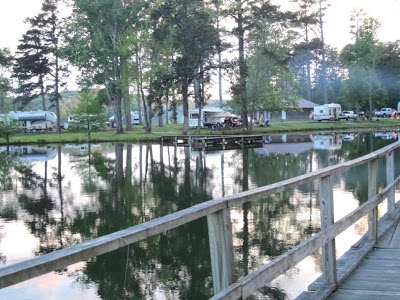The main reason for my dislike is the close spacing of the campsites and no privacy at most of them. With our slides out, I felt like we
were encroaching on our neighbors picnic area. The only redeeming thing about this site is the open space behind our campsite which allowed for bank fishing. The site was not very deep and did not allow for parking our truck in front of the fifth wheel unless we angled it in. This was site #37 in campground loop B. Loop A had no access to the lake. I could not find any pictures online before we reserved this campground and I thought these sites backed up to the lake and would have good access for
fishing. However, there was so much brush and woods that only a few feet were accessible. With the negative out of the way, I will say that my husband caught a few nice size fish (bream and catfish). This site was $18 per night for water/elec. There is a dump station and a nice bathhouse with a washer/dryer.
While we were at Natchez, we decided to have a look around this historic town and we found a "plantation" that is a part of the
National Park Service. It is called Melrose and was built in the late 1840s by a Pennsylvania man, John McMurran. He was a lawyer and state legislator. A tour of the grounds gave a glimpse of how these people lived back in the mid 1800s. The "main house" was huge and elaborate. The front faced the garden area while all the other buildings were in the back.
The kitchen was in a separate building, as was the custom to lessen the chance of fire in the main house. Another building that looked identical to the kitchen was directly across from it. It housed the dairy and laundry.
There was one well pump next to the laundry, one next to the kitchen and another next to the slave quarters.
There was also a garage (carriage house) with several period
carriages.
 The slave quarters were 2 frame houses quite removed from the rest of the buildings. I found it peculiar that this plantation was owned by a Pennsylvania man (a Yankee), yet he owned several slaves. It is my understanding that Melrose was not a crop plantation (like cotton). The slaves
The slave quarters were 2 frame houses quite removed from the rest of the buildings. I found it peculiar that this plantation was owned by a Pennsylvania man (a Yankee), yet he owned several slaves. It is my understanding that Melrose was not a crop plantation (like cotton). The slaves were mainly for the running of the household, carriage drivers, tending the vegetable garden and fruit orchards.
One of the most memorable things on our stay in Natchez is the moss hanging on the trees. I found this to be quite beautiful and eerie at the same time.
We camped at Natchez State Park on Thursday, May 9 and Friday, May 10, 2013.
























.JPG)




























